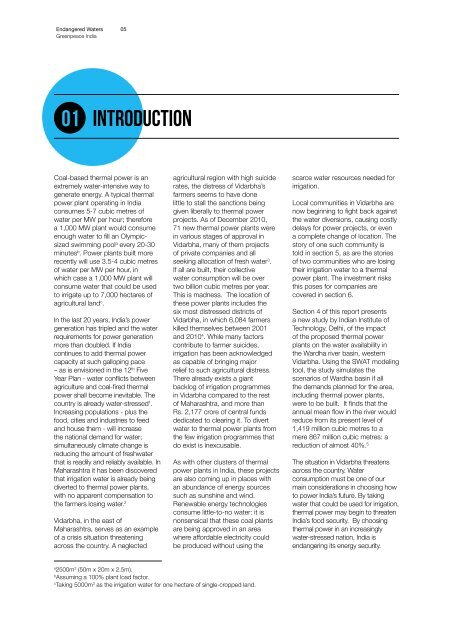Endangered Waters - Greenpeace
Endangered Waters - Greenpeace
Endangered Waters - Greenpeace
Create successful ePaper yourself
Turn your PDF publications into a flip-book with our unique Google optimized e-Paper software.
<strong>Endangered</strong> <strong>Waters</strong><br />
<strong>Greenpeace</strong> India<br />
05<br />
01<br />
INTRODUCTION<br />
Coal-based thermal power is an<br />
extremely water-intensive way to<br />
generate energy. A typical thermal<br />
power plant operating in India<br />
consumes 5-7 cubic metres of<br />
water per MW per hour; therefore<br />
a 1,000 MW plant would consume<br />
enough water to fill an Olympicsized<br />
swimming pool a every 20-30<br />
minutes b . Power plants built more<br />
recently will use 3.5-4 cubic metres<br />
of water per MW per hour, in<br />
which case a 1,000 MW plant will<br />
consume water that could be used<br />
to irrigate up to 7,000 hectares of<br />
agricultural land c .<br />
In the last 20 years, India’s power<br />
generation has tripled and the water<br />
requirements for power generation<br />
more than doubled. If India<br />
continues to add thermal power<br />
capacity at such galloping pace<br />
– as is envisioned in the 12 th Five<br />
Year Plan - water conflicts between<br />
agriculture and coal-fired thermal<br />
power shall become inevitable. The<br />
country is already water-stressed 1 .<br />
Increasing populations - plus the<br />
food, cities and industries to feed<br />
and house them - will increase<br />
the national demand for water;<br />
simultaneously climate change is<br />
reducing the amount of freshwater<br />
that is readily and reliably available. In<br />
Maharashtra it has been discovered<br />
that irrigation water is already being<br />
diverted to thermal power plants,<br />
with no apparent compensation to<br />
the farmers losing water. 2<br />
Vidarbha, in the east of<br />
Maharashtra, serves as an example<br />
of a crisis situation threatening<br />
across the country. A neglected<br />
agricultural region with high suicide<br />
rates, the distress of Vidarbha’s<br />
farmers seems to have done<br />
little to stall the sanctions being<br />
given liberally to thermal power<br />
projects. As of December 2010,<br />
71 new thermal power plants were<br />
in various stages of approval in<br />
Vidarbha, many of them projects<br />
of private companies and all<br />
seeking allocation of fresh water 3 .<br />
If all are built, their collective<br />
water consumption will be over<br />
two billion cubic metres per year.<br />
This is madness. The location of<br />
these power plants includes the<br />
six most distressed districts of<br />
Vidarbha, in which 6,084 farmers<br />
killed themselves between 2001<br />
and 2010 4 . While many factors<br />
contribute to farmer suicides,<br />
irrigation has been acknowledged<br />
as capable of bringing major<br />
relief to such agricultural distress.<br />
There already exists a giant<br />
backlog of irrigation programmes<br />
in Vidarbha compared to the rest<br />
of Maharashtra, and more than<br />
Rs. 2,177 crore of central funds<br />
dedicated to clearing it. To divert<br />
water to thermal power plants from<br />
the few irrigation programmes that<br />
do exist is inexcusable.<br />
As with other clusters of thermal<br />
power plants in India, these projects<br />
are also coming up in places with<br />
an abundance of energy sources<br />
such as sunshine and wind.<br />
Renewable energy technologies<br />
consume little-to-no water: it is<br />
nonsensical that these coal plants<br />
are being approved in an area<br />
where affordable electricity could<br />
be produced without using the<br />
scarce water resources needed for<br />
irrigation.<br />
Local communities in Vidarbha are<br />
now beginning to fight back against<br />
the water diversions, causing costly<br />
delays for power projects, or even<br />
a complete change of location. The<br />
story of one such community is<br />
told in section 5, as are the stories<br />
of two communities who are losing<br />
their irrigation water to a thermal<br />
power plant. The investment risks<br />
this poses for companies are<br />
covered in section 6.<br />
Section 4 of this report presents<br />
a new study by Indian Institute of<br />
Technology, Delhi, of the impact<br />
of the proposed thermal power<br />
plants on the water availability in<br />
the Wardha river basin, western<br />
Vidarbha. Using the SWAT modeling<br />
tool, the study simulates the<br />
scenarios of Wardha basin if all<br />
the demands planned for the area,<br />
including thermal power plants,<br />
were to be built. It finds that the<br />
annual mean flow in the river would<br />
reduce from its present level of<br />
1,419 million cubic metres to a<br />
mere 867 million cubic metres: a<br />
reduction of almost 40%. 5<br />
The situation in Vidarbha threatens<br />
across the country. Water<br />
consumption must be one of our<br />
main considerations in choosing how<br />
to power India’s future. By taking<br />
water that could be used for irrigation,<br />
thermal power may begin to threaten<br />
India’s food security. By choosing<br />
thermal power in an increasingly<br />
water-stressed nation, India is<br />
endangering its energy security.<br />
a<br />
2500m 3 (50m x 20m x 2.5m).<br />
b<br />
Assuming a 100% plant load factor.<br />
c<br />
Taking 5000m 3 as the irrigation water for one hectare of single-cropped land.

















